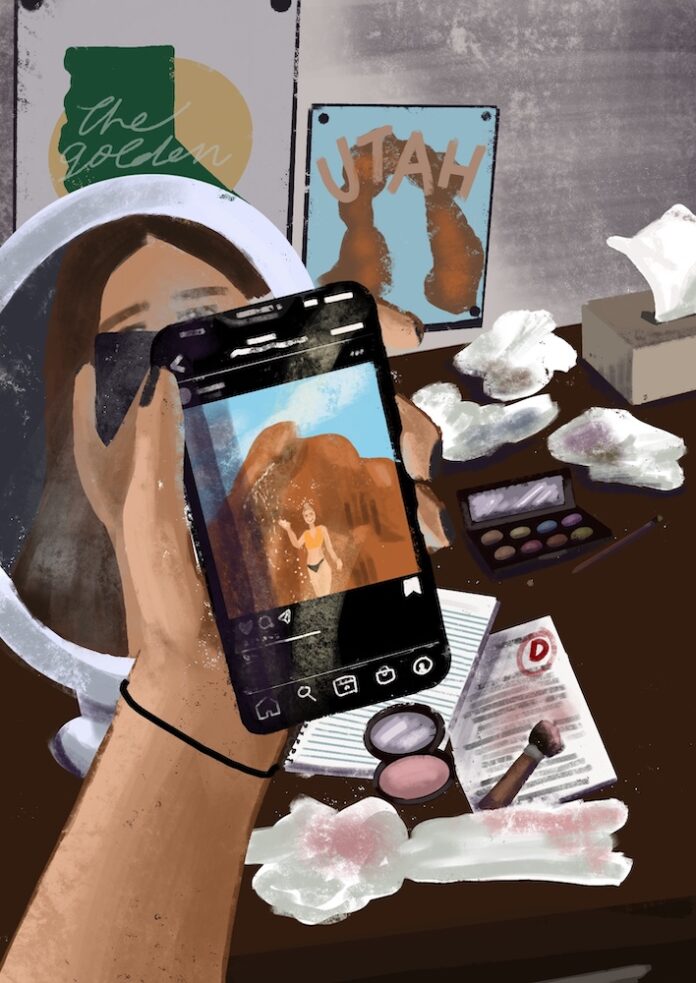Content Warning: This article contains discussions on relationship abuse, violence and death.
Endless photos of sand-colored rocks balanced in stillness coupled with romantic flicks of a happy couple dominated Gabby Petito’s Instagram. Such images contrast greatly with the recently exposed reality of Petito’s personal life, one that ended in strangulation this past September after the 22-year-old self-proclaimed nutritionist and travel blogger quit her job at a juice bar to embark on a cross-country road trip with her fiancé, Brian Laundrie.
For young, attractive couples, such a plan is not uncommon: the so-called “van life” is considered an achievement, forever traveling the world together in a cramped camper van. However, Petito’s story wasn’t like this.
It never was.
Petito was found dead at the Bridger-Teton National Forest in September, just 10 days after she was reported missing by her parents. Laundrie, who was declared a person of interest in her murder investigation Sept. 21, was also found dead in October. This news came after the Moab City Police Department released body camera footage involving Laundrie and Petito in response to a reported physical altercation.
Petito’s tragic murder has sparked vigorous conversations about relationship abuse and media racism. Both are incredibly important conversations — but I also think it’s worth considering what lessons we can take from her portrayal of a happy, problem-free life on social media.
Examining the serenity and simplicity of Petito’s Instagram account made me instantly aware of her youth and the naiveté that comes with having social media. Even though it can take a team of 10 people to manage a celebrity’s Instagram account, Generation Z and Millennials alike want to dive head first into the social media industry. We’re taught from a young age to not talk to strangers, but here we are, sharing our entire lives with countless faceless usernames for the sake of being an “influencer.”
Being a social media influencer is a high-paying job if you gain a certain number of followers. But it’s not just for the money — in a study, Gen Z and Millennials want to become influencers to make a difference in the world, share certain work with a large audience or find the opportunity to become a self-employed entrepreneur. For Instagram, in particular, the visual aspect is the key to success, which means posting only the good moments and pretty aesthetics. As a result, Instagram accounts are full of superficial, “I’m happy all the time” moments.
The irony is thick: Instagram and social media act as a glimpse into our personal lives, but our personal lives look nothing like how we portray them. As a result, research shows that teenagers who spend more time on Instagram are more likely to experience negative psychological symptoms, including depression and lower self-esteem. Female-identifying college students are also especially more likely to use Instagram while experiencing negative feelings toward themselves and their lives. Since Instagram is designed to function like a drug, our addiction impacts our mental health and wellbeing. We’ve become a generation that depends on the validation of others, the double-clicking action that constitutes a “like” — but how far are we willing to go for a single photo?
I must be clear, I am in no way stating that Petito died because of social media and because of her posting on Instagram. Petito’s death was a homicide and her murder could easily have happened without a social media presence. However, the stark differences between her posts and her reality should signify to natives of social media that we must navigate carefully. We must be vigilant of the consuming power of upholding illusions and understand that just as we keep the flaws and struggles of our personal lives to the people we trust, so do others.
Because Instagram is heavily based on images, we get used to the idea that our lives revolve around what is online — the notion that “it didn’t really happen unless you posted it.” But this is dangerous and isolating. It leads us to believe that people around us don’t go through the common struggles of life. In reality, though, no one lives the same lives they post on social media because no one lives their lives in a spread of pictures and captions.
One of the grim details of this story is that it’s not just Petito who posted images that may not have been reflective of her life — it’s all of us. It’s all of us who are on social media that continue to post our ideas of a perfect lifestyle — myself included. Instagram is part of our current social culture. And, of course, it’s fun to post and create aesthetics and imagine living in a world that is far too detached from reality. It’s unrealistic to suggest that a whole generation of people would quit social media instantly. But, we must be wary of the price we pay for using it. In such a digitally based age, sometimes it seems the only things we share as humans are the weather and our imperfect movement through life. And even though we know that our lives are imperfect, we still love to post as if they aren’t. Maybe the next time we find ourselves scrolling through social media, we will be mindful of the temporary nature of pictures and its separation from our real lives. Let’s wake up from the dreams we’ve created on our own Instagram pages.
![]()



































